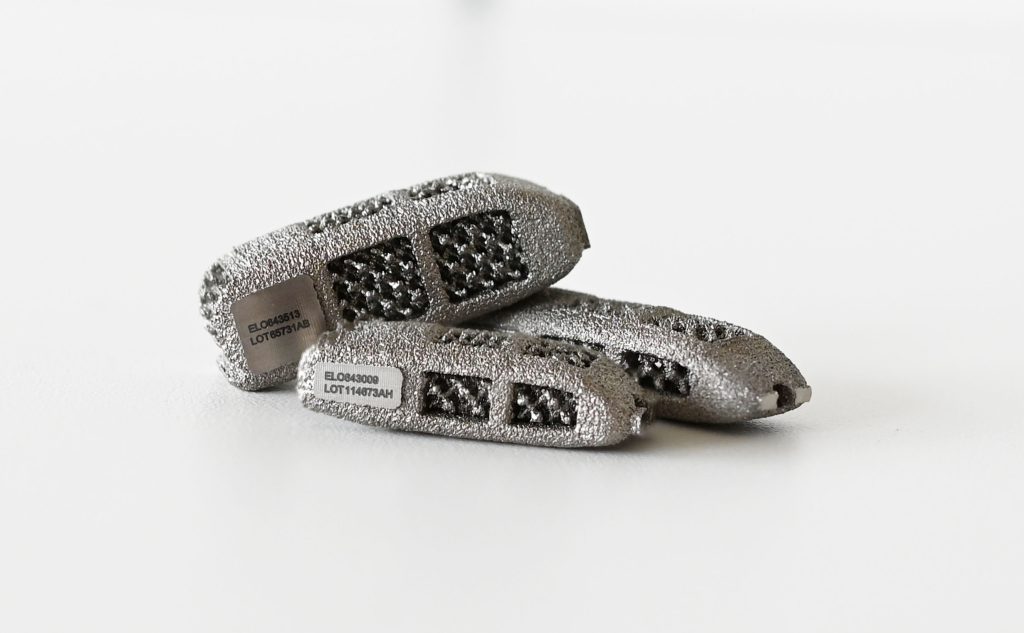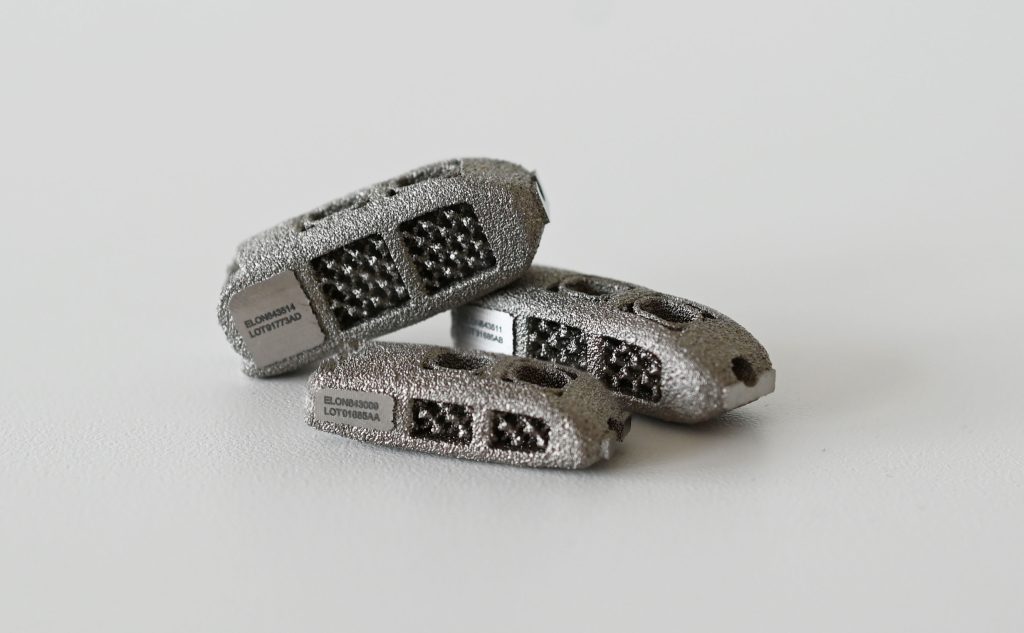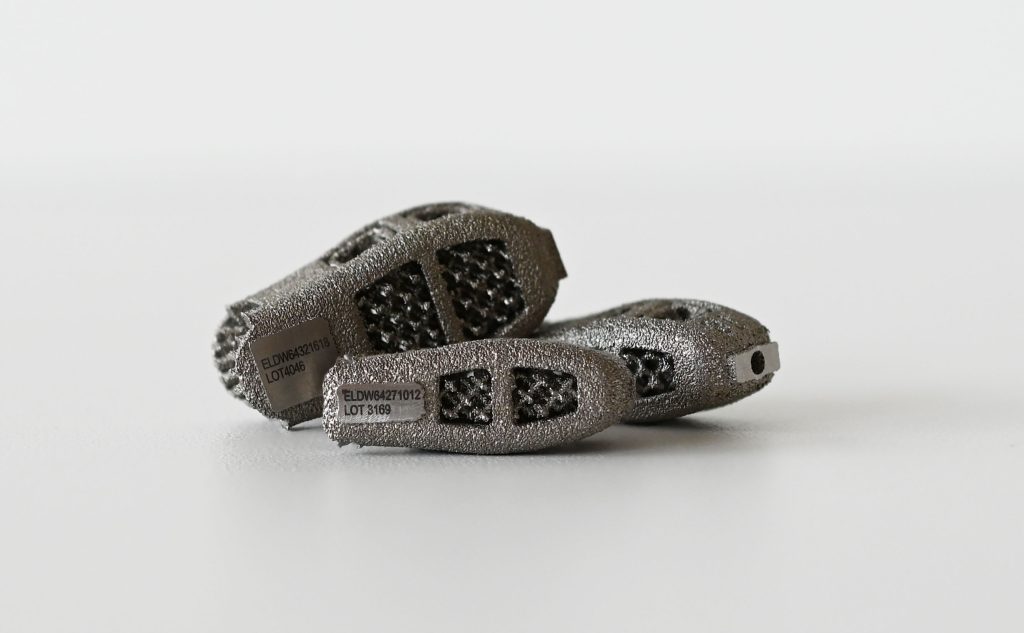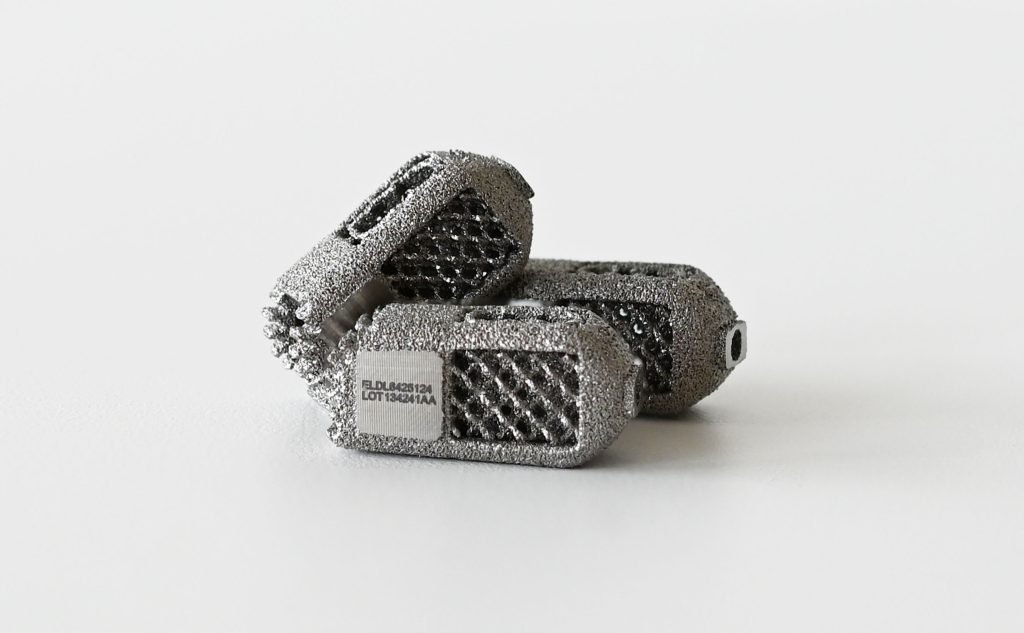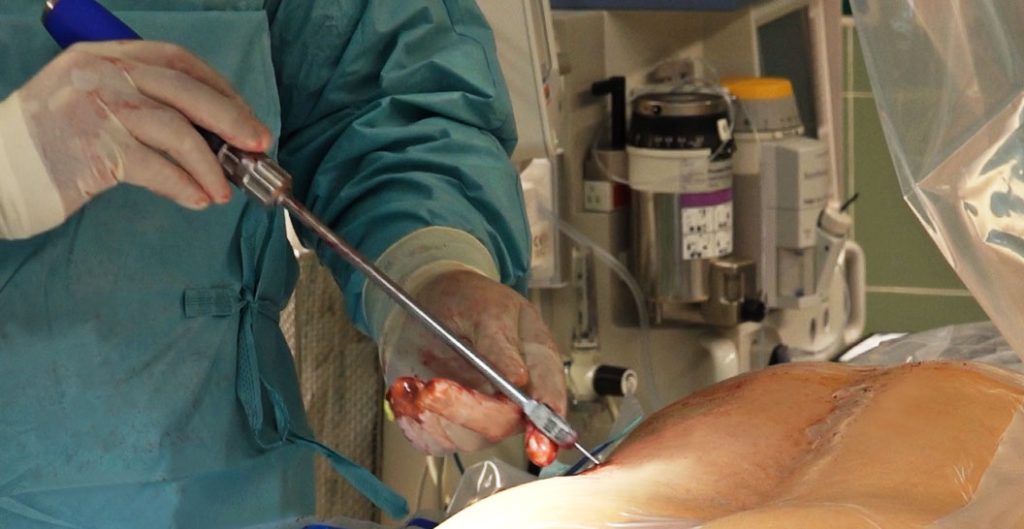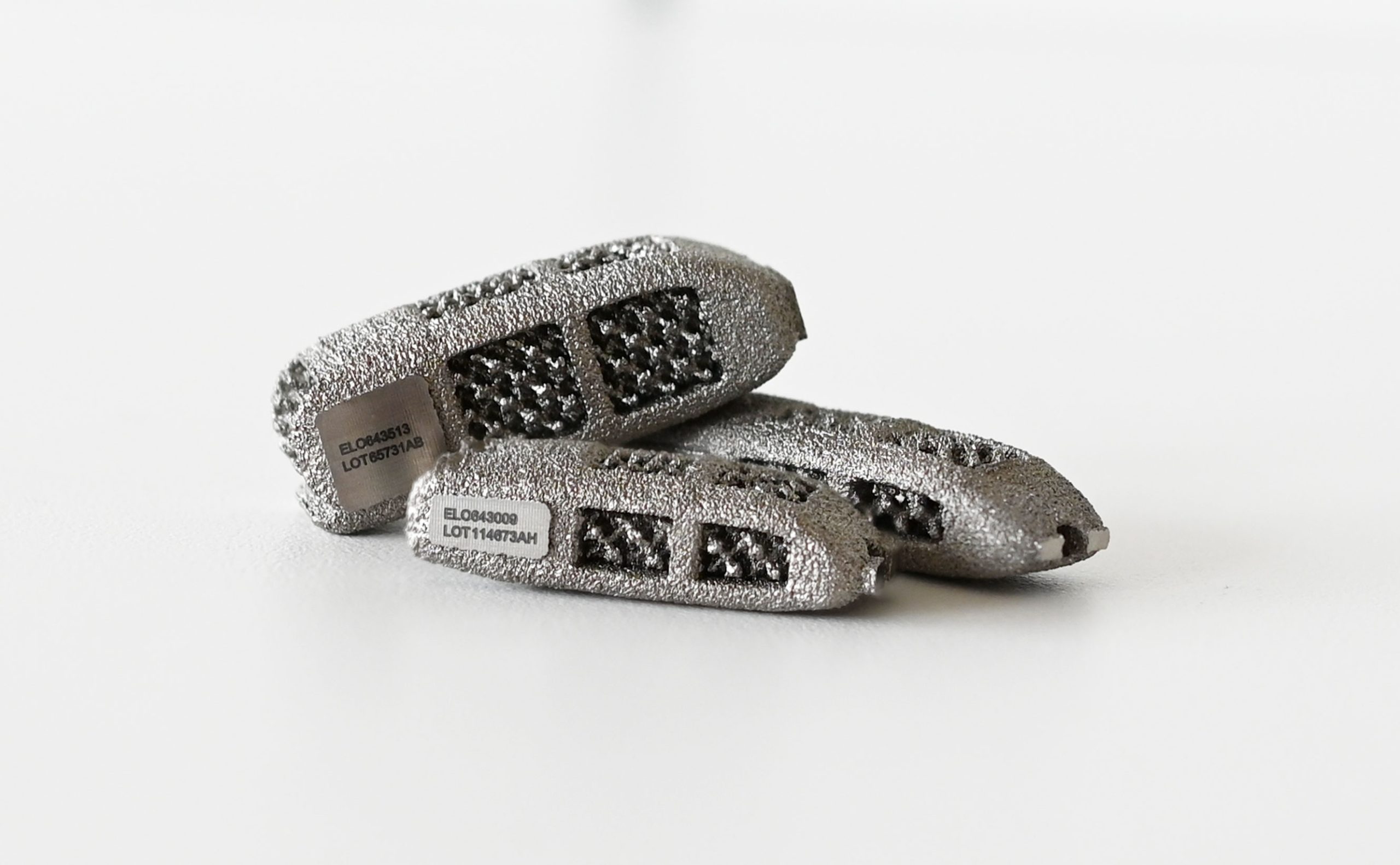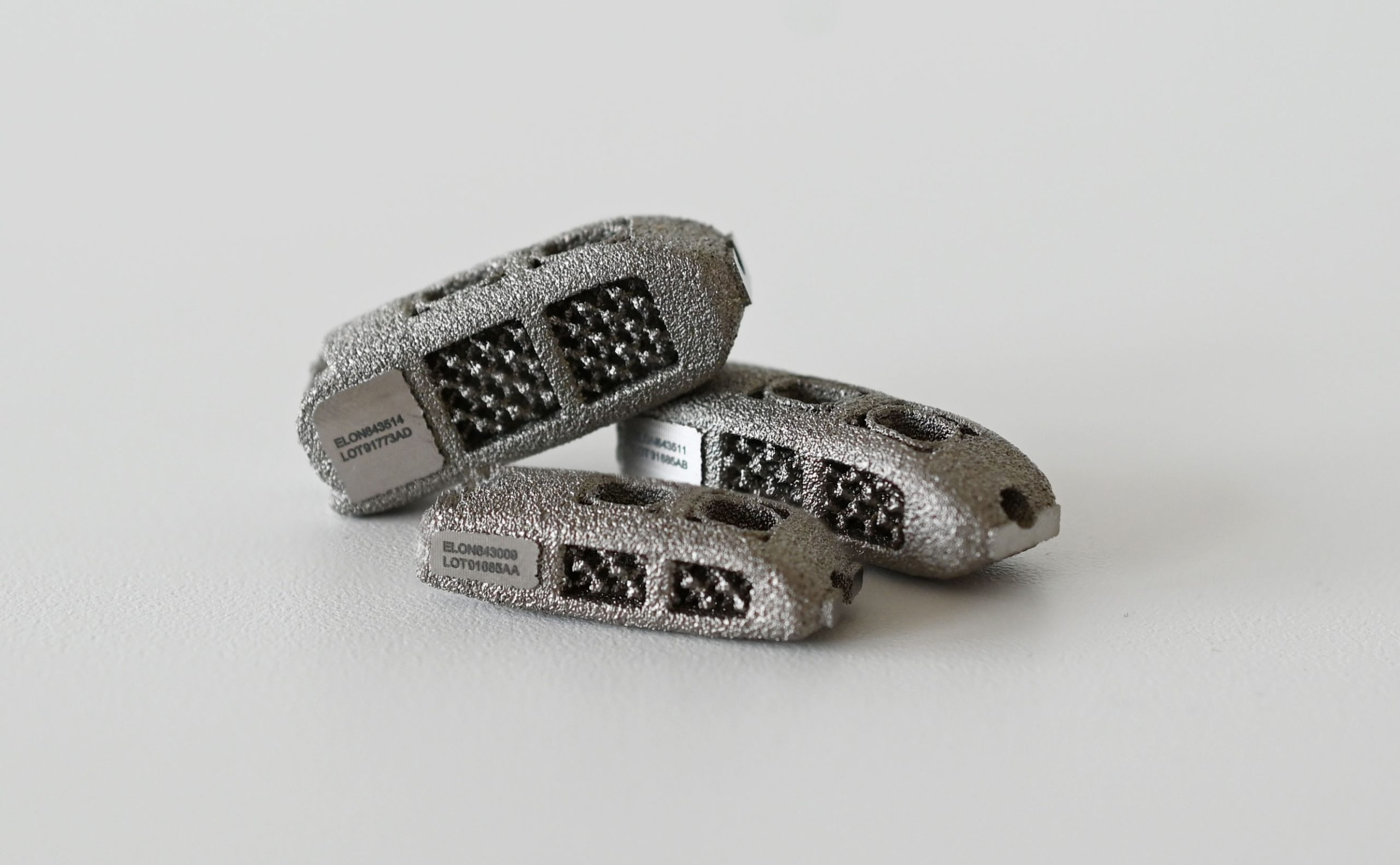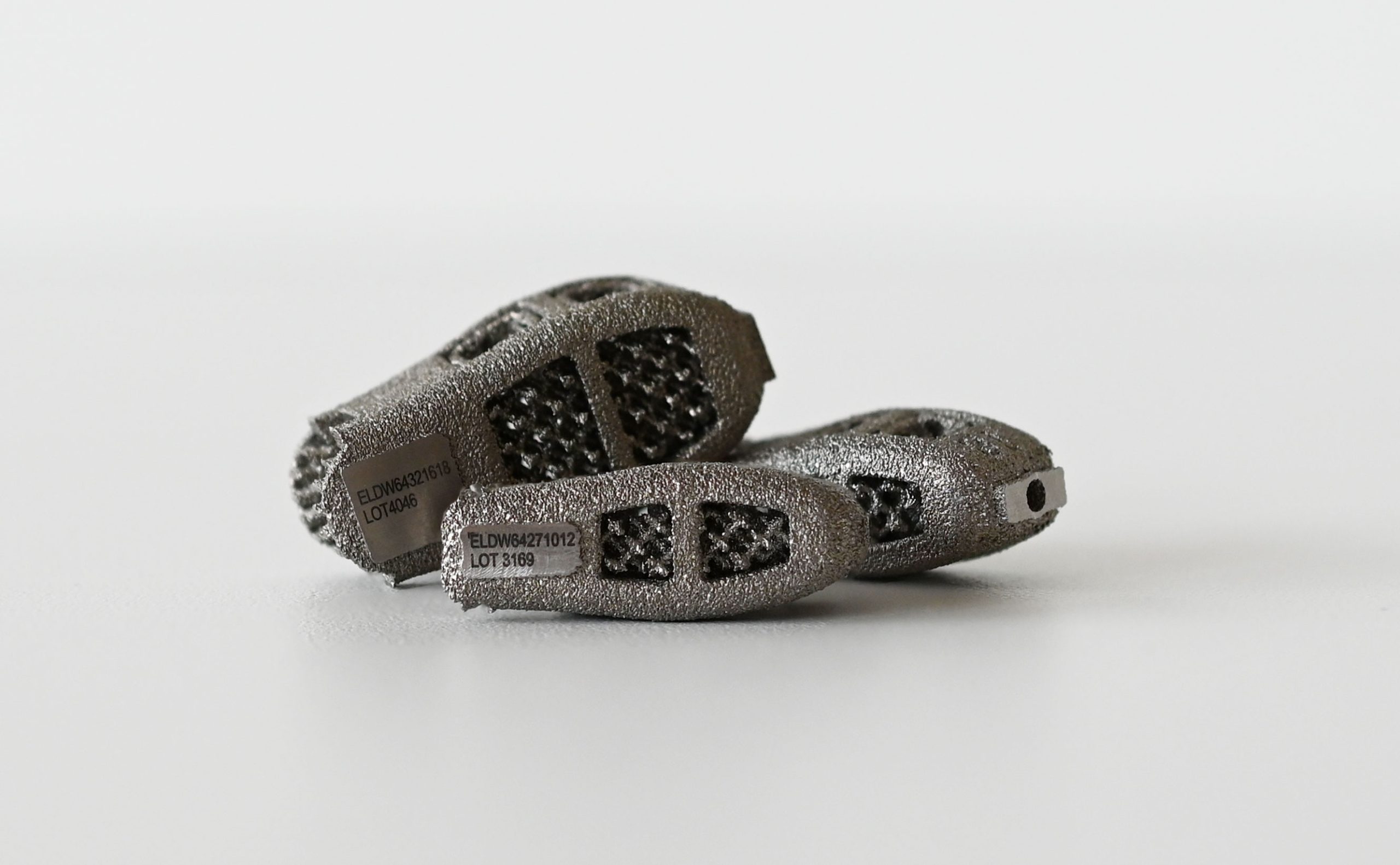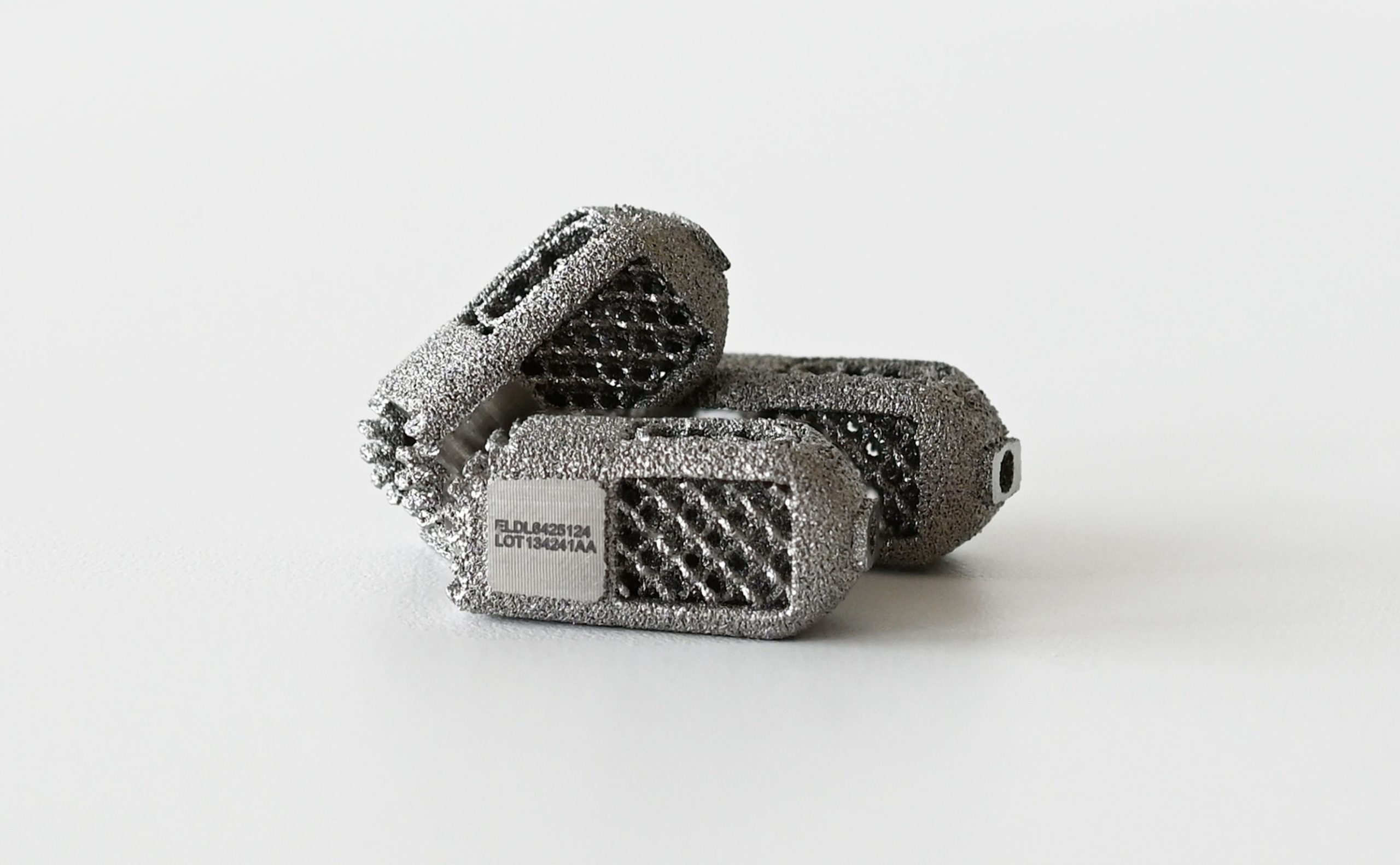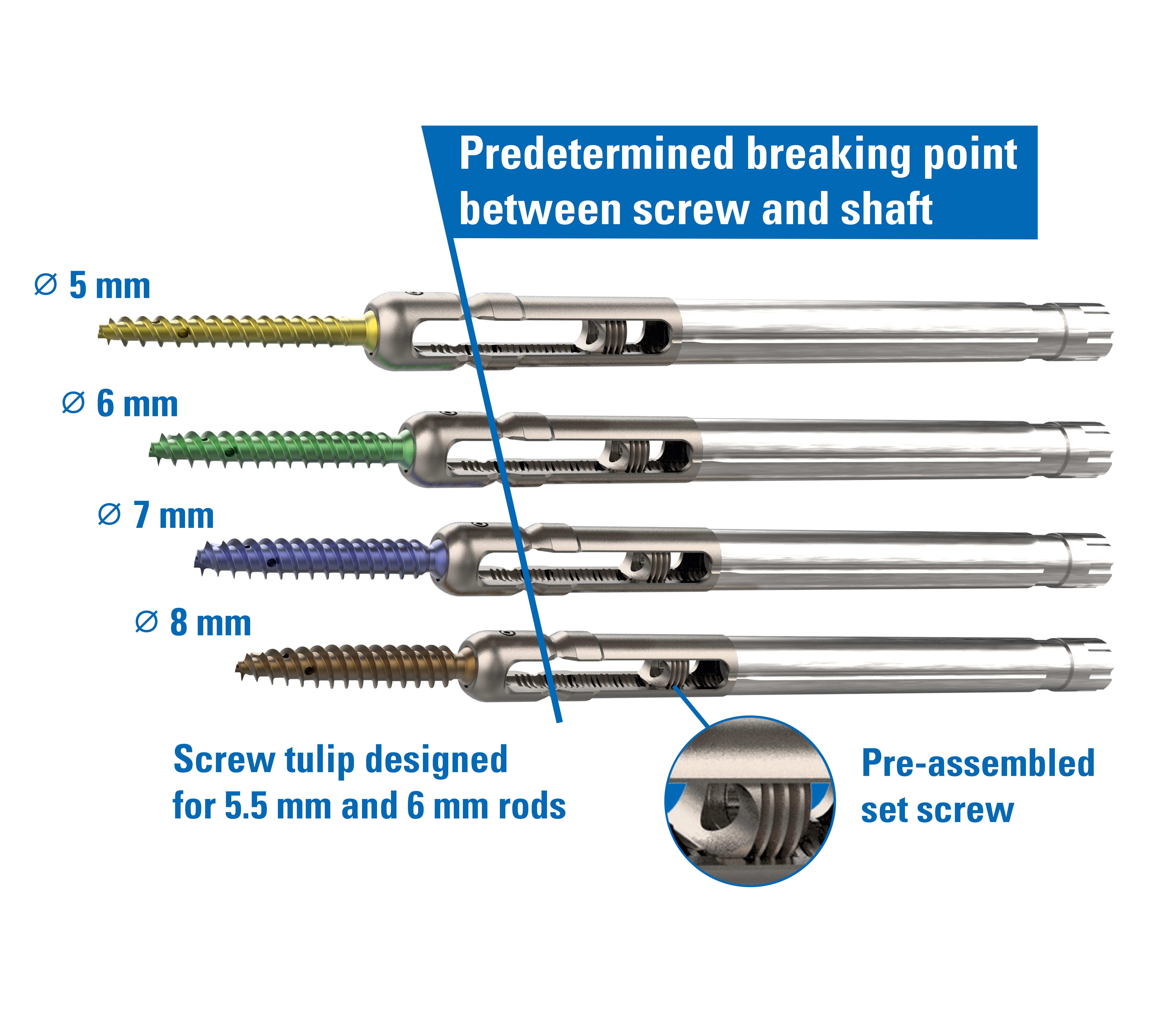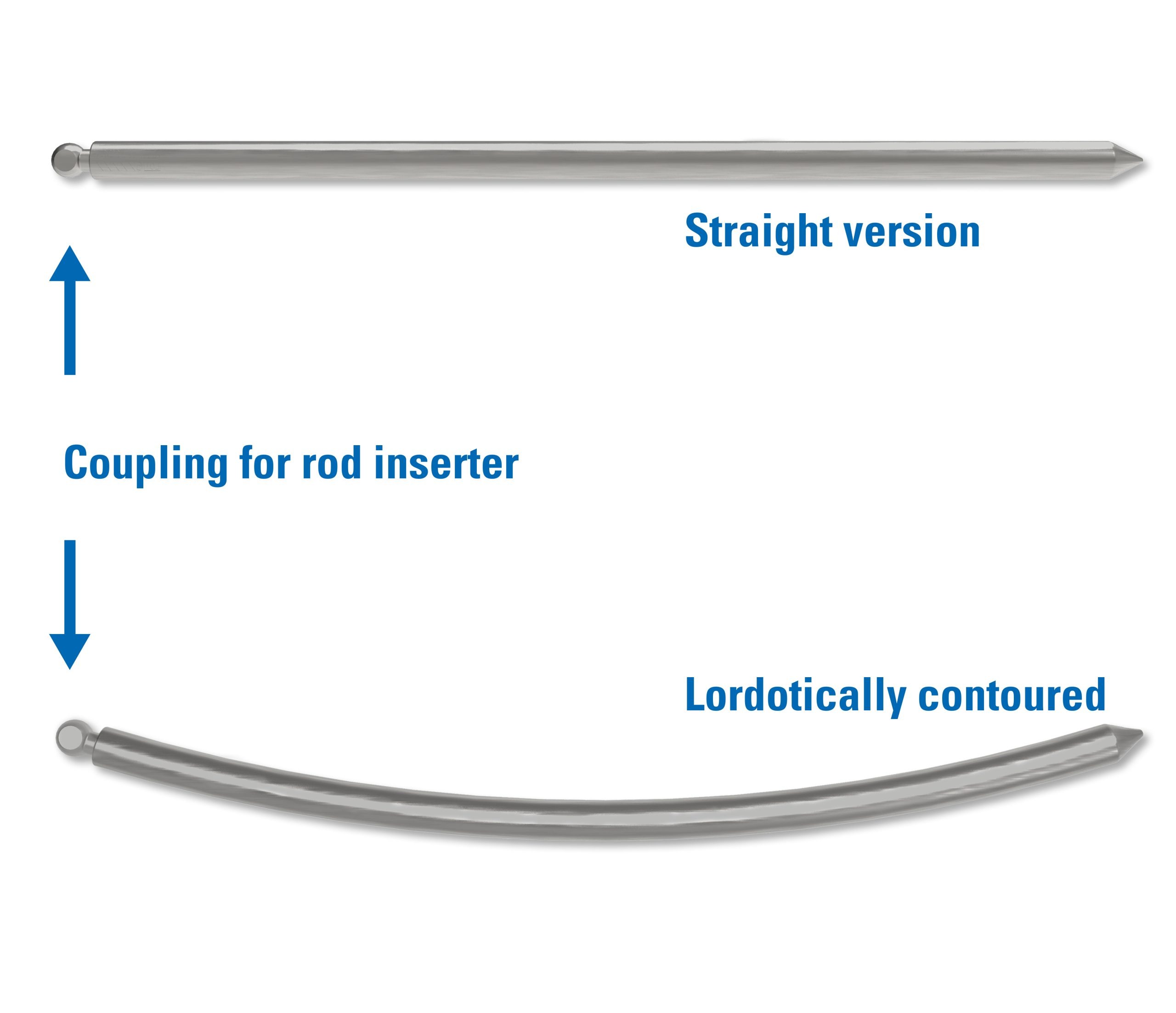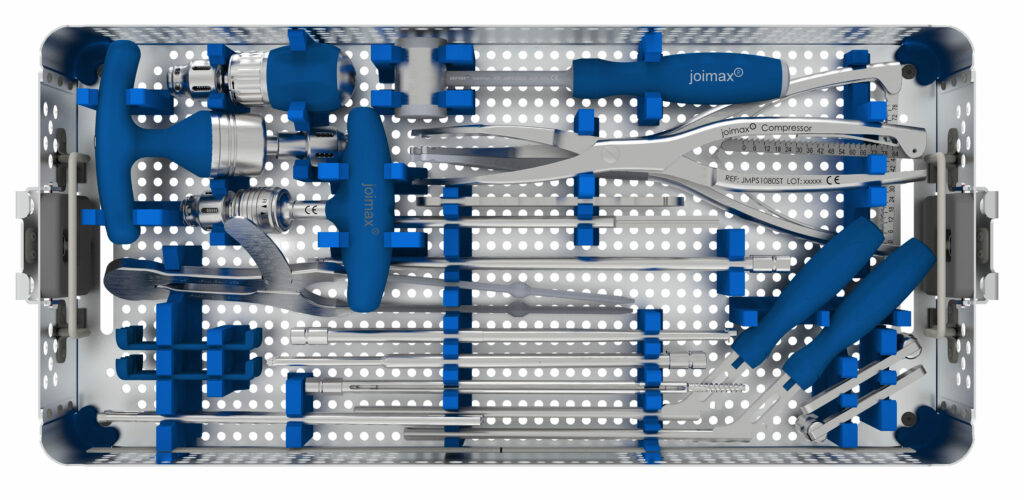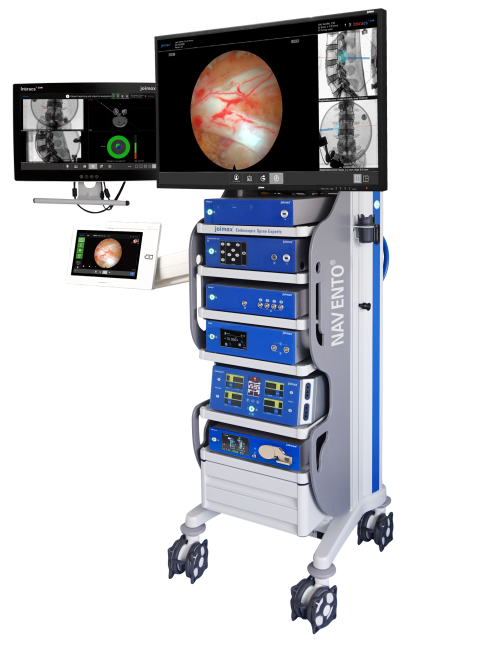Stabilization
Our minimally invasive solutions for lumbar spinal stabilization include the endoscopically assisted implantation of EndoLIF® Cages for vertebral body fusion as well as the screw-rod system Percusys® Plus for dorsal fixation.
The EndoLIF® Concept
With the EndoLIF® concept, joimax® is consistently pursuing the path of endoscopic and endoscopically assisted spinal surgery towards endoscopic fusion. The EndoLIF® approach is derived from the proven TESSYS® method. However, it can also be used without previous knowledge in the application of TESSYS®.
General advantages of the EndoLIF® access
The EndoLIF® access offers the possibility to dilate the tissue between the muscle groups by specifically designed dilators. This is especially atraumatic and tissue-conserving. Discectomy and insertion of the implants is performed endoscopically assisted via the access channel. For the EndoLIF® Oblique access, no dorsal bony structures need to be removed. Thus, fusion can be performed without major structural damage. Furthermore, the multifidus muscle, which is important for the stability of the back, remains completely intact1. Alternatively, the EndoPLIF access offers a gentle posterior path through the interlaminar window.
- Minimally invasive surgery, endoscopically (assisted) fusion
- Gentle and atraumatic gradual tissue dilatation
- Muscles remain intact2
- Reduced risk of infection
- Shorter recovery time
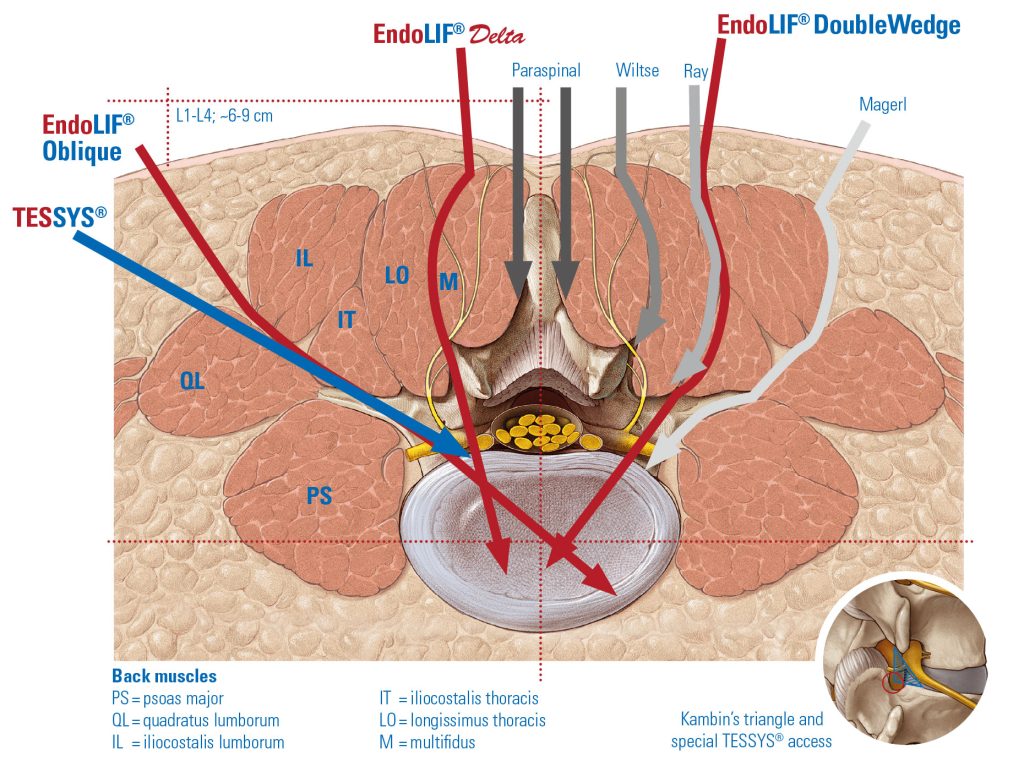
Advantages of the EndoLIF® O/On-Cage
- Access to the intervertebral disc through the Kambin triangle
- Implantation after decompression with TESSYS®
- Preservation of the stabilizing structures such as
dorsal bony structures, muscles and ligaments
Advantages of the EndoLIF® DoubleWedge-Cage
- Anatomically shaped TLIF-Cage for optimal lordotic correction
- Minimally invasive implantation for maximal lordotic correction
Advantages of the EndoLIF® Delta-Cage
- Posterior interlaminar access
- Implantation after decompression with iLESSYS® Delta
- Easy access to L5/S1due to large interlaminar window
Minimally invasive endoscopic spine surgery
Minimally invasive spine surgery has proven to be a favored and reliable method for a multitude of pathologies. Today, spinal decompression can be achieved through various methods utilizing small access channels to the spine. Several methods have already been implemented in everyday surgeries within the last couple of years. Additionally, implants can now be introduced through minimally invasive techniques, e.g. percutaneous screw-rod systems, with significant reduction of tissue trauma. Experienced users consider endoscopic surgical methods as a gentle alternative to microsurgical techniques. Scientific studies also confirm that endoscopic surgery offers advantages over microsurgery3.
The EndoLIF® Concept
With the EndoLIF® concept, joimax® is consistently pursuing the path of endoscopic and endoscopically assisted spinal surgery towards endoscopic fusion. The EndoLIF® approach is derived from the proven TESSYS® method. However, it can also be used without previous knowledge in the application of TESSYS®.
General advantages of the EndoLIF® access
The EndoLIF® access offers the possibility to dilate the tissue between the muscle groups by specifically designed dilators. This is especially atraumatic and tissue-conserving. Discectomy and insertion of the implants is performed endoscopically assisted via the access channel. For the EndoLIF® Oblique access, no dorsal bony structures need to be removed. Thus, fusion can be performed without major structural damage. Furthermore, the multifidus muscle, which is important for the stability of the back, remains completely intact1. Alternatively, the EndoPLIF access offers a gentle posterior path through the interlaminar window.
- Minimally invasive surgery, endoscopically (assisted) fusion
- Gentle and atraumatic gradual tissue dilatation
- Muscles remain intact2
- Reduced risk of infection
- Shorter recovery time

Advantages of the EndoLIF® O/On-Cage
- Access to the intervertebral disc through the Kambin triangle
- Implantation after decompression with TESSYS®
- Preservation of the stabilizing structures such as
dorsal bony structures, muscles and ligaments
Advantages of the EndoLIF® DoubleWedge-Cage
- Anatomically shaped TLIF-Cage for optimal
lordotic correction - Minimally invasive implantation for maximal
lordotic correction
Advantages of the EndoLIF® Delta-Cage
- Posterior interlaminar access
- Implantation after decompression with iLESSYS® Delta
- Easy access to L5/S1due to large interlaminar window
Minimally invasive endoscopic spine surgery
Minimally invasive spine surgery has proven to be a favored and reliable method for a multitude of pathologies. Today, spinal decompression can be achieved through various methods utilizing small access channels to the spine. Several methods have already been implemented in everyday surgeries within the last couple of years. Additionally, implants can now be introduced through minimally invasive techniques, e.g. percutaneous screw-rod systems, with significant reduction of tissue trauma. Experienced users consider endoscopic surgical methods as a gentle alternative to microsurgical techniques. Scientific studies also confirm that endoscopic surgery offers advantages over microsurgery3.
The EndoLIF® Concept
With the EndoLIF® concept, joimax® is consistently pursuing the path of endoscopic and endoscopically assisted spinal surgery towards endoscopic fusion. The EndoLIF® approach is derived from the proven TESSYS® method. However, it can also be used without previous knowledge in the application of TESSYS®.

General advantages
of the EndoLIF® access
The EndoLIF® access offers the possibility to dilate the tissue between the muscle groups by specifically designed dilators. This is especially atraumatic and tissue-conserving. Discectomy and insertion of the implants is performed endoscopically assisted via the access channel. For the EndoLIF® Oblique access, no dorsal bony structures need to be removed. Thus, fusion can be performed without major structural damage. Furthermore, the multifidus muscle, which is important for the stability of the back, remains completely intact1. Alternatively, the EndoPLIF access offers a gentle posterior path through the interlaminar window.
- Minimally invasive surgery, endoscopically (assisted) fusion
- Gentle and atraumatic gradual tissue dilatation
- Muscles remain intact2
- Reduced risk of infection
- Shorter recovery time
Advantages of the EndoLIF® O/On-Cage
- Access to the intervertebral disc through the Kambin triangle
- Implantation after decompression with TESSYS®
- Preservation of the stabilizing structures such as dorsal bony structures, muscles and ligaments
Advantages of the EndoLIF® DoubleWedge-Cage
- Anatomically shaped TLIF-Cage for optimal lordotic correction
- Minimally invasive implantation for maximal lordotic correction
Advantages of the EndoLIF® Delta-Cage
- Posterior interlaminar access
- Implantation after decompression with iLESSYS® Delta
- Easy access to L5/S1due to large interlaminar window
Advantages of the
EndoLIF® O/On-Cage
- Access to the intervertebral disc through the Kambin triangle
- Implantation after decompression with TESSYS®
- Preservation of the stabilizing structures such as dorsal bony structures, muscles and ligaments
Advantages of the
EndoLIF® DoubleWedge-Cage
- Anatomically shaped TLIF-Cage for optimal lordotic correction
- Minimally invasive implantation for maximal lordotic correction
Advantages of the
EndoLIF® Delta-Cage
- Posterior interlaminar access
- Implantation after decompression with iLESSYS® Delta
- Easy access to L5/S1due to large interlaminar window
Minimally invasive endoscopic spine surgery
Minimally invasive spine surgery has proven to be a favored and reliable method for a multitude of pathologies. Today, spinal decompression can be achieved through various methods utilizing small access channels to the spine. Several methods have already been implemented in everyday surgeries within the last couple of years. Additionally, implants can now be introduced through minimally invasive techniques, e.g. percutaneous screw-rod systems, with significant reduction of tissue trauma. Experienced users consider endoscopic surgical methods as a gentle alternative to microsurgical techniques. Scientific studies also confirm that endoscopic surgery offers advantages over microsurgery3.
Minimally invasive
endoscopic spine surgery
Minimally invasive spine surgery has proven to be a favored and reliable method for a multitude of pathologies. Today, spinal decompression can be achieved through various methods utilizing small access channels to the spine. Several methods have already been implemented in everyday surgeries within the last couple of years. Additionally, implants can now be introduced through minimally invasive techniques, e.g. percutaneous screw-rod systems, with significant reduction of tissue trauma. Experienced users consider endoscopic surgical methods as a gentle alternative to microsurgical techniques. Scientific studies also confirm that endoscopic surgery offers advantages over microsurgery3.
Percusys® Plus – Percutaneous screw-rod-system for lumbar dorsal spinal stabilization
Percusys® Plus is a multifunctional screw-rod system that has been developed for fixation, reconstruction and fusion of vertebrae in the area of the non-cervical spinal column. The small, concise instrument set is especially designed for minimally invasive procedures. However, it is suitable for all surgical techniques and can be used for both, percutaneous and open surgery based.
Selected indications
- Degenerative disc disease
- Spondylolisthesis
- Trauma (i.e. fracture, dislocation)
- Spinal stenosis
- Curvatures (i.e. scoliosis, kyphosis, and/or lordosis)
- Tumor
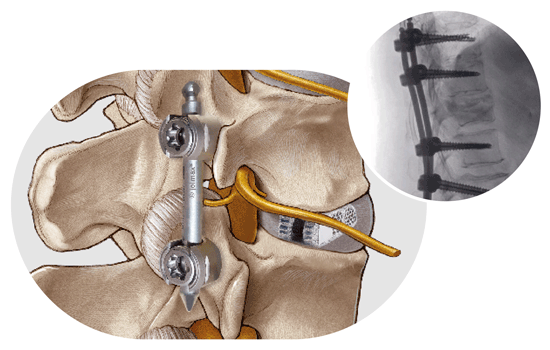
The Percusys® Plus implants
The patented Percusys® Plus pedicle screws have a unique characteristic design with firmly connected extension shafts optimized for percutaneous surgery. The screws are available in various diameters and lengths, and the different sizes are indicated by color coding. All screws are available with monoaxial or polyaxial screw heads and have a pre-loaded set screw. A cannulation enables safe implantation over a guide wire. Additionally, all screw variants are fenestrated, self-tapping and self-drilling for easy implantation.
Percusys® Plus rods are available in different diameters for additional stability. Depending on the anatomical conditions and individual preferences, the surgeon can choose between lordotic pre-bent and straight rods.
All Percusys® Plus implants are made of the titanium alloy Ti6Al4V.
The Percusys® Plus instrument set
The Percusys® Plus instrument set contains all necessary instruments for spinal stabilization and is perfectly matched to the latest LIF methods, such as treatment with EndoLIF® implants. All instruments required for implantation of the screws and rods are included in one tray. Additional instruments, e.g. for revision, are located on a small revision tray.
The advantages – efficient, extremely slim and a unique design
- One instrument tray for all screw implantations and common surgical applications
- All screws are sterile packed, cannulated, fenestrated, self-drilling, self-tapping and provided with a double thread
- Pre-assembled set-screw
- Special coupling system inside the screw head for cement application or radiopaque or saline injection
- The lengthening shaft – multifunctional and particularly slim design
- The shaft breaker with special T-handle for easy handling without high effort
Percusys® Plus – Percutaneous screw-rod-system for lumbar dorsal spinal stabilization
Percusys® Plus is a multifunctional screw-rod system that has been developed for fixation, reconstruction and fusion of vertebrae in the area of the non-cervical spinal column. The small, concise instrument set is especially designed for minimally invasive procedures. However, it is suitable for all surgical techniques and can be used for both, percutaneous and open surgery based.
Selected indications
- Degenerative disc disease
- Spondylolisthesis
- Trauma (i.e. fracture, dislocation)
- Spinal stenosis
- Curvatures (i.e. scoliosis, kyphosis, and/or lordosis)
- Tumor

Percusys® Plus – Percutaneous
screw-rod-system for lumbar dorsal spinal stabilization
Percusys® Plus is a multifunctional screw-rod system that has been developed for fixation, reconstruction and fusion of vertebrae in the area of the non-cervical spinal column. The small, concise instrument set is especially designed for minimally invasive procedures. However, it is suitable for all surgical techniques and can be used for both, percutaneous and open surgery based.
- Degenerative disc disease
- Spondylolisthesis
- Trauma (i.e. fracture, dislocation)
- Spinal stenosis
- Curvatures (i.e. scoliosis, kyphosis,
and/or lordosis) - Tumor

The Percusys® Plus implants
The patented Percusys® Plus pedicle screws have a unique characteristic design with firmly connected extension shafts optimized for percutaneous surgery. The screws are available in various diameters and lengths, and the different sizes are indicated by color coding. All screws are available with monoaxial or polyaxial screw heads and have a pre-loaded set screw. A cannulation enables safe implantation over a guide wire. Additionally, all screw variants are fenestrated, self-tapping and self-drilling for easy implantation.
Percusys® Plus rods are available in different diameters for additional stability. Depending on the anatomical conditions and individual preferences, the surgeon can choose between lordotic pre-bent and straight rods.
All Percusys® Plus implants are made of the titanium alloy Ti6Al4V.
The Percusys® Plus implants
The patented Percusys® Plus pedicle screws have a unique characteristic design with firmly connected extension shafts optimized for percutaneous surgery. The screws are available in various diameters and lengths, and the different sizes are indicated by color coding. All screws are available with monoaxial or polyaxial screw heads and have a pre-loaded set screw. A cannulation enables safe implantation over a guide wire. Additionally, all screw variants are fenestrated, self-tapping and self-drilling for easy implantation.
Percusys® Plus rods are available in different diameters for additional stability. Depending on the anatomical conditions and individual preferences, the surgeon can choose between lordotic pre-bent and straight rods.
All Percusys® Plus implants are made of the titanium alloy Ti6Al4V.
The Percusys® Plus instrument set
The Percusys® Plus instrument set contains all necessary instruments for spinal stabilization and is perfectly matched to the latest LIF methods, such as treatment with EndoLIF® implants. All instruments required for implantation of the screws and rods are included in one tray. Additional instruments, e.g. for revision, are located on a small revision tray.
The Percusys® Plus instrument set
The Percusys® Plus instrument set contains all necessary instruments for spinal stabilization and is perfectly matched to the latest LIF methods, such as treatment with EndoLIF® implants. All instruments required for implantation of the screws and rods are included in one tray. Additional instruments, e.g. for revision, are located on a small revision tray.
The advantages – efficient, extremely slim and a unique design
- One instrument tray for all screw implantations and common surgical applications
- All screws are sterile packed, cannulated,
fenestrated, self-drilling, self-tapping and provided
with a double thread - Pre-assembled set-screw
- Special coupling system inside the screw head for
cement application or radiopaque or saline injection - The lengthening shaft – multifunctional and particularly slim design
- The shaft breaker with special T-handle for easy handling without high effort
The advantages – efficient, extremely slim and a unique design
- One instrument tray for all screw implantations and common surgical applications
- All screws are sterile packed, cannulated,
fenestrated, self-drilling, self-tapping and provided
with a double thread - Pre-assembled set-screw
- Special coupling system inside the screw head for
cement application or radiopaque or saline injection - The lengthening shaft – multifunctional and particularly slim design
- The shaft breaker with special T-handle for easy handling without high effort
- One instrument tray for all screw implantations and common surgical applications
- All screws are sterile packed, cannulated, fenestrated, self-drilling, self-tapping and provided with a double thread
- Pre-assembled set-screw
- Special coupling system inside the screw head for cement application or radiopaque or saline injection
- The lengthening shaft – multifunctional and particularly slim design
- The shaft breaker with special T-handle for easy handling without high effort
The advantages – efficient, extremely slim and a unique design
- One instrument tray for all screw implantations and common surgical applications
- All screws are sterile packed, cannulated, fenestrated, self-drilling, self-tapping and
provided with a double thread - Pre-assembled set-screw
- Special coupling system inside the screw head for cement application or radiopaque
or saline injection - The lengthening shaft – multifunctional and particularly slim design
- The shaft breaker with special T-handle for easy handling without high effort
Disclaimers
Certain products may not be approved for sale in all countries.
Bibliography
- Kim CW et al. The Current State of Minimally Invasive Spine Surgery. JBJS 93.6 (2011): 582-596.
- Kim, C. et al.: The Current State of Minimally Invasive Spine Surgery In: The Journal of Bone & Joint Surgery, Volume 93-A, Number 6, 2011;93:pp582-596.
- Gibson, A. et al.: Long-term functional outcomes following transforaminal endoscopic surgery RCT data to two years. In: European Spine Journal (2013) 22 (Suppl 1):p57; Presented at BASS 2013
NAVENTO® Knows No Limits!
NAVENTO® is a fully integrated and equipped endoscopic tower that includes all 4th generation joimax® devices required for endoscopic access.
It offers the complete package with the latest technology and coordinated functions of all devices.
This enables the user to master endoscopic spinal surgery in all its diversity and offers growth potential for the expansion of skills and indications.
NAVENTO® knows no limits!
